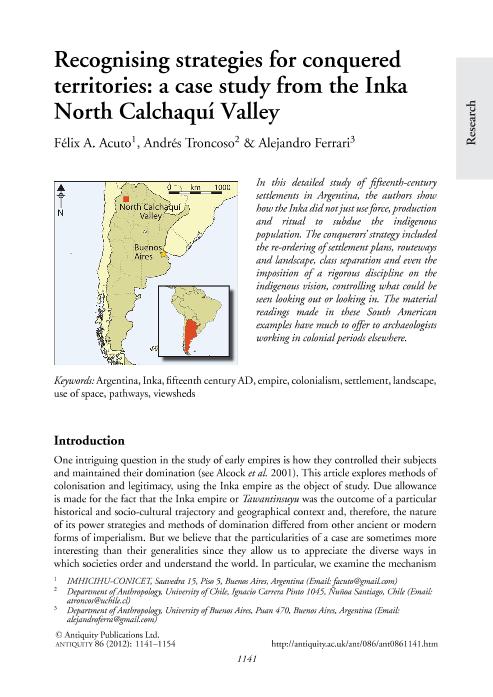Artículo
Recognising strategies for conquered territories: a case study from the Inka North Calchaquí Valley
Fecha de publicación:
12/2012
Editorial:
Cambridge University Press
Revista:
Antiquity
ISSN:
0003-598X
e-ISSN:
1745-1744
Idioma:
Inglés
Tipo de recurso:
Artículo publicado
Clasificación temática:
Resumen
One major concern regarding the study of ancient empires is how they ruled and controlled their subjects and justified their domination (see Alcock et al. 2001). This article explores ancient empires’ strategies of colonization and legitimacy, the Inka Empire’s in this case, taking into account that the Inka Empire or Tawantinsuyu was the outcome of a particular historical and socio-cultural trajectory and geographical context and, therefore, the nature of its power strategies and methods of domination differed from other ancient or modern forms of imperialism. We believe that the particularities of each case are sometimes more interesting than their similarities since they allow us to appreciate the diverse ways in which societies order and understand the world. This paper offers a case study that will contribute to deepen our understanding of the variability of ancient imperialism and that students of past empires can use to compare and contrast with their own cases. Here we examine Inka rule over the North Calchaquí Valley (Figure 1), showing that the strategic use of architecture and the manipulation of people’s corporal experience within Inka places were key aspects of Tawantinsuyu’s domination in the region.
Palabras clave:
Imperio Inka
,
Valle Calchaquí Norte
,
Estrategias de Dominio
,
Arquitectura
Archivos asociados
Licencia
Identificadores
Colecciones
Articulos(IMHICIHU)
Articulos de INST.MULTIDISCIP.DE HISTORIA Y CS.HUMANAS
Articulos de INST.MULTIDISCIP.DE HISTORIA Y CS.HUMANAS
Citación
Ferrari, Alejandro Andrés; Troncoso Melendez, Andres Rolando; Acuto, Felix Alejandro; Recognising strategies for conquered territories: a case study from the Inka North Calchaquí Valley; Cambridge University Press; Antiquity; 86; 334; 12-2012; 1141-1154
Compartir
Altmétricas




